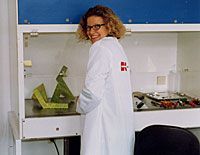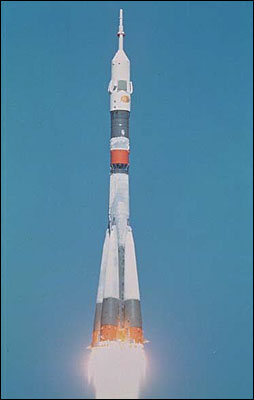cosmic dancer - a space art intervention by arthur woods
Cosmic Dancer in the Mir spacesuit chamber.

Cosmonaut Gennadi Manakov unpacking the Cosmic Dancer and moving it into the Mir station.
The Spaceflight of the Cosmic Dancer
One of my previous partners on the OUR-SPS project, Kayser-Threde Gmbh in Munich, became a German agent for the Russian space program. From them I learned that the Russian space program was still open for business and they would welcome another project from myself and the OURS Foundation. The geometric shapes of the Cosmic Dancer sculpture series seemed to be most appropriate for evaluating the idea of exploring the concept of sculpture in the microgravity environment of a space habitat such as on the US Space Shuttle or the Mir space station. From a technical standpoint, the Cosmic Dancer would be a much less complex project to realize than the previous projects. As the first three-dimensional artwork to be specifically conceived for and officially realized in a space habitat, the Cosmic Dancer project would also serve to ascertain the process, impact and value of integrating a cultural dimension into the human space program.
Taking a similar approach as was used with the earlier OUR-SPS project, both the US and the Russian space agencies were contacted about possible launch opportunities. In September, 1992, a proposal for a spaceflight of a Cosmic Dancer on the US shuttle was sent to NASA which responded that their policy of not allowing "non-scientific payloads" on the orbiter was still in effect. Simultaneously, a similar proposal to launch a Cosmic Dancer sculpture to the Russian Mir space station was submitted to NPO Energia via Kayser-Threde GmbH which led to an offer and to signing a “Letter of Intent” in November. Negotiations for the launch date and the determination of the technical specifications commenced. In December, a contract between the OURS Foundation and Kayser-Threde was signed to launch the sculpture to the Mir space station on a Progress supply vehicle with launch opportunities available in March or May of 1993. The cost, based maximum payload weight of 1 kilogram, was set at approximately US $100,000 which included the launch, testing, the filming of the sculpture on the Mir station and the return of the documentation to Earth.
To meet the funding requirements in the short time available, an intense search was made to find a potential sponsor. However, the companies that responded were interested in “branding” the sculpture with their company’s name which was unacceptable as this would detract and compromise the purpose of the project. Consequently, I again took a “crowd funding” approach and created a limited edition of the Cosmic Dancer sculpture which was made available to space enthusiasts and art collectors. 99 versions of the Cosmic Dancer, the same exact size and material (square aluminum tubing) as the flight sculpture, were painted in my pointillistic technique. Each sculpture was finished in a different color scheme making each of the 99 versions a unique and original artwork. These sculptures were then offered to the public through various art galleries and through advertisements in the print media.
For its integration in the Mir station a Cosmic Dancer sculpture would have to be both compact and lightweight. The weight limit of 1 kg was set by the contract and the approximate dimensions of 35 x 35 x 40 cm enabled the Cosmic Dancer to easily pass through the air locks and module ports of the Mir station. Several prototype sculptures were constructed out of wood to these dimensions and painted in my pointillistic technique. One of these prototype sculptures was delivered to NPO Energia for cosmonaut training purposes. A training exercise with the sculpture was conducted by cosmonauts Gennadi Manakow and Alexander Polishchuk at the Mir station mock-up located at the cosmonaut training facility at Star City, Russia in December. The cosmonauts simulated the Cosmic Dancer in the Mir station by suspending the sculpture with a nylon monofilament line from the ceiling. A video recording and photographs of this exercise were made and delivered to the OURS Foundation. The two cosmonauts were launched to the Mir space station for a six-month tour of duty in January, 1993

Star City pre-flight training with cosmonauts Gennadi Manakov and Alexander Polischuk.
Standard water-based acrylic polymer artist paints (Lascaux Studio Acrylic Paints) were used for the surface finish. The paints to be used had to satisfy toxic out-gassing standards for the Mir environment and samples of each color were sent to NPO Energia in Moscow for testing and these were subsequently approved. In addition, the sculpture would have to be sterilized by submersion in an alcohol solution prior to launch. As acrylic paint reacts negatively to alcohol, a suitable varnish that could support the sterilization procedure and not affect the acrylic paint had to be utilized. A two-component epoxy varnish was found that satisfied this requirement.
To minimize flammability and to ensure structural stability during the launch phase, hollow 40 mm square aluminum tubing with a wall thickness of 2 mm was chosen as a suitable material and a contractor was selected for its construction. The material was cut to the exact dimensions of the wooden prototype sculpture. To meet the weight requirements of 1 kg, the original thickness of the aluminum tubes had to be reduced by magnetic sanding all of the sides. The pieces were then assembled by welding.
The color scheme selected for the flight sculpture was based on the following criteria: (1) The sculpture had to have sufficient contrast with the Mir environment in order to insure that good images could be obtained on film and video and, (2) it should offer an aesthetic contribution to the cosmonauts living quarters. With these two considerations as a guide, a dominant green color scheme for the flight sculpture was chosen.
This decision was reached after viewing photographs and video tapes of the Mir station interior which indicated a somewhat drab, technical environment crowded and cluttered with equipment and cables. In contrast, from the view portals, the cosmonauts could observe the blackness of space and the blue and white of the Earth. Green was also considered because of its association with terrestrial plants and the psychologically calming effects that associations with nature are reported to induce. In the photographs of the Mir interior, there appeared to be very little of this color in its brighter intensities in the Mir station environment.

The flight sculpture was thus painted in this color scheme, finished with the approved epoxy varnish and delivered to Kayser-Threde in March, 1993, which then carried out the sterilization procedures, dried the sculpture in an exhaust oven and vacuum-packed it for delivery to Russia. There, officials from NPO Energia prepared the Cosmic Dancer sculpture for spaceflight by attaching it to a specially manufactured aluminum base-plate and placing it into a sack. This package was integrated into the faring of a Progress rocket at the Baikonur Cosmodrome in Kazakhstan.

On May 22, at 10:41:47 a.m. (Moscow time), a Soyuz-U2 rocket was launched to the Mir space station with the Progress M-18 cargo spacecraft carrying the Cosmic Dancer sculpture, supplies and other equipment. Two days later, after its arrival at the Mir space station, cosmonauts Gennadi Manakov and Alexander Polishchuk unpacked the Cosmic Dancer and allowed it to freely float and spin in their living space. A 12 min. video transmission was broadcast from the Mir station to the ground control center in June and delivered to the OURS Foundation. As part of the mission, the cosmonat crew were instructed to evaluate the impact of having art share their weightless environment and were given a questionnaire. A total of 26 photographs, 9 color slides, a 28 min. video film in Beta Broadcast quality plus a recorded commentary of their experience were made. This project documentation was returned to Earth in September 1993.
Due to the limited space available in the Soyuz crew return capsule, the cost to return the Cosmic Dancer to Earth was as high as the spaceflight and was not included in the original budget. As NASA had begun flights with the US orbiter to the Mir station in the meantime, this presented a possibility. The National Air & Space Museum in Washington D.C. was contacted and asked if they would be interested in obtaining the Cosmic Dancer for the Smithsonian collection on the condition that NASA would return the sculpture to Earth. The museum officials agreed to this proposal but NASA declined, again citing the restriction on not flying "non-scientific payloads” on the Space Shuttle. The Cosmic Dancer was never returned to Earth and it is assumed it was on-board when the Mir space station was de-orbited into the Pacific Ocean in March 2001.
It has been shown that gravity has played a subtle yet important role in the development of our art and culture. As human civilization is extended beyond the planet, its culture will be altered by the environment of outer space and we can expect art to take on new dimensions as it is created for and, eventually, in this environment. Since art and society are interdependent, art will play an important role in sensitizing human society to new environments in outer space. On a practical level, the Cosmic Dancer project demonstrated that it is possible for an individual or a private organization to conduct a small-scale experiment in space but more importantly, by adding a cultural dimension to outer space development it helps to bridge the terrestrial and extraterrestrial environments of human civilization.
